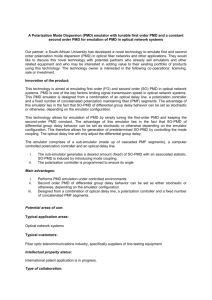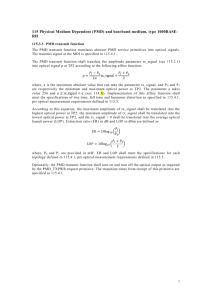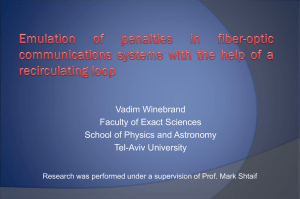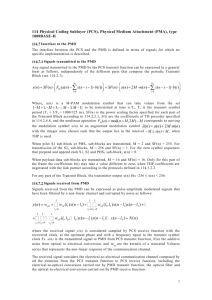EVOLUTION OF RANDOM VECTORS ALONG SINGLE
advertisement
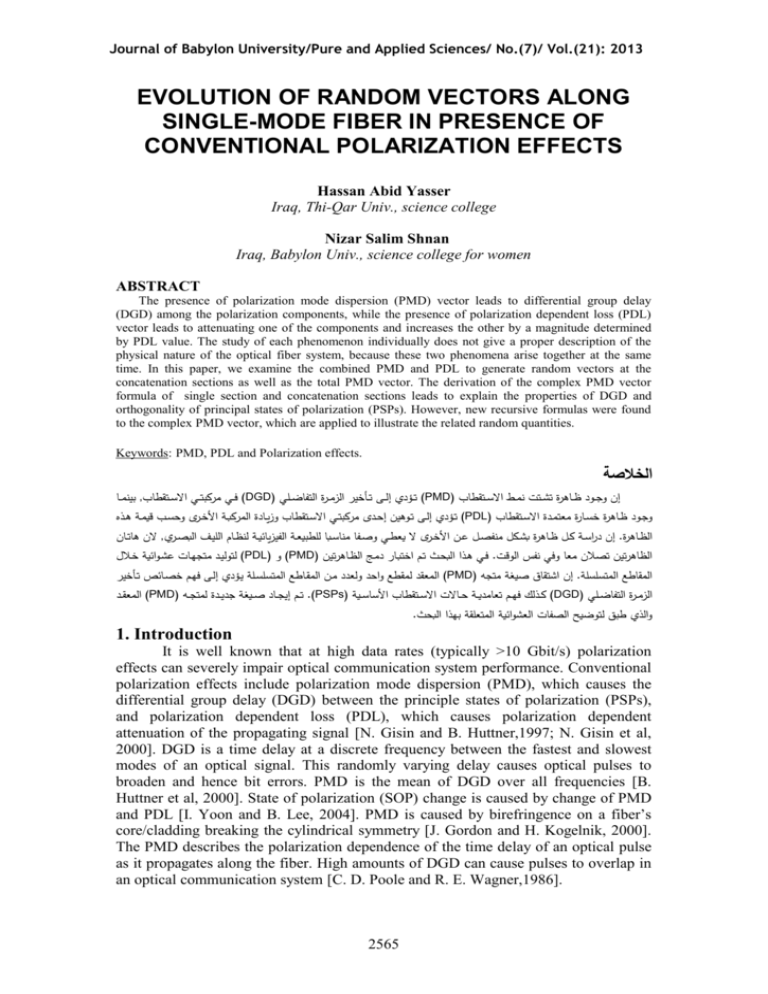
Journal of Babylon University/Pure and Applied Sciences/ No.(7)/ Vol.(21): 2013 EVOLUTION OF RANDOM VECTORS ALONG SINGLE-MODE FIBER IN PRESENCE OF CONVENTIONAL POLARIZATION EFFECTS Hassan Abid Yasser Iraq, Thi-Qar Univ., science college Nizar Salim Shnan Iraq, Babylon Univ., science college for women ABSTRACT The presence of polarization mode dispersion (PMD) vector leads to differential group delay (DGD) among the polarization components, while the presence of polarization dependent loss (PDL) vector leads to attenuating one of the components and increases the other by a magnitude determined by PDL value. The study of each phenomenon individually does not give a proper description of the physical nature of the optical fiber system, because these two phenomena arise together at the same time. In this paper, we examine the combined PMD and PDL to generate random vectors at the concatenation sections as well as the total PMD vector. The derivation of the complex PMD vector formula of single section and concatenation sections leads to explain the properties of DGD and orthogonality of principal states of polarization (PSPs). However, new recursive formulas were found to the complex PMD vector, which are applied to illustrate the related random quantities. Keywords: PMD, PDL and Polarization effects. الخالصة ا يمست و تووة تو ( و ) ف و تشتي وDGD و ول و ظت تشتقووة ذزووش وك و ق ووشإا (ن ت و ن ي اووة مل ا ووة سهو ا مو ) وويظإ إ ووخ وولزمش لت وشتPMD ( و ) وويظإ إ ووخ وووتمن إكووظ تشتي وPDL ووة ألوون ذزووش ( ا و و و تس ووق ) و موظ ت جاو ا ألنوو ا ة زوالPDL ) وPMD قكوم وا ز قو ش ظتوه هو تش من ولزمش و ة مويظإ إ وخ فاوا ز و ا ) تا ووظPMD و غة جظمووظت ت جووه إن وجوووظ ه و تشت ن و ا ستووا ( و وجوووظ هو تشت ز و شت تا تووظت ( و هو تشتإ إن ظش ووة تووة هو تشت قنووتة تس الن تا وف س س و اإ فو تو ) تا ظ ت ع و كظ و اظظ تون ت و ع تPMD غة ت جه )إ ووا إمج و ظPSPs و ة ذ ةإ إن ن ق ) ت و ف فاووا ا تظ ووة ك و (ا ( وDGD قكمإ ه تش من ا انو ا ة ت ا ة يا ح ع ت و ت لت وشت و إ يق و 1. Introduction It is well known that at high data rates (typically >10 Gbit/s) polarization effects can severely impair optical communication system performance. Conventional polarization effects include polarization mode dispersion (PMD), which causes the differential group delay (DGD) between the principle states of polarization (PSPs), and polarization dependent loss (PDL), which causes polarization dependent attenuation of the propagating signal [N. Gisin and B. Huttner,1997; N. Gisin et al, 2000]. DGD is a time delay at a discrete frequency between the fastest and slowest modes of an optical signal. This randomly varying delay causes optical pulses to broaden and hence bit errors. PMD is the mean of DGD over all frequencies [B. Huttner et al, 2000]. State of polarization (SOP) change is caused by change of PMD and PDL [I. Yoon and B. Lee, 2004]. PMD is caused by birefringence on a fiber’s core/cladding breaking the cylindrical symmetry [J. Gordon and H. Kogelnik, 2000]. The PMD describes the polarization dependence of the time delay of an optical pulse as it propagates along the fiber. High amounts of DGD can cause pulses to overlap in an optical communication system [C. D. Poole and R. E. Wagner,1986]. 2565 The PDL on a linear scale is defined as the ratio between the maximum and minimum attenuation coefficient over all polarization states. While this quantity can be measured by using scrambling and recording the maximum and minimum attenuation it is usually measured using the Jones matrix or Muller matrix method [L. Chen L et al, 2007; M. Shtaif and O. Rosenberg, 2005]. PDL describes the polarization dependence of the optical attenuation for different states of polarization and can occur concurrently with PMD in fibers [Y. Li and A. Yariv, 2005; G.P. Agrawal, 2005]. PDL is a varying insertion loss arising from the dependence of a component’s transmission coefficient on the SOP [M. Shtaif and O. Rosenberg, 2005]. In a complex system with; optical fibers, couplers, filters, multiplexers/ demultiplexers, variable optical attenuators, erbium doped optical amplifiers, and add/drop multiplexing switchers, the combination of PMD and PDL will lead to a complex PSP vector [G.P. Agrawal, 2005; D. S. Waddy et al, 2003]. The combined PMD-PDL interaction can further degrade the system performance. Due to the interference between the fast and slow modes, the interaction between these effects will make an optical system more complicated than PMD or PDL alone. It may result in anomalous dispersion and causes additional signal distortion [M. Wang et al, 2003]. It is known that this interaction causes the fast and slow PSP direction to become nonorthogonal [C. Xie and L. F. Mollenauer, 2003]. This non-orthogonality is related to the imaginary part of the PSP vector or Differential Slope Atenuation (DSA) [S. Yang et al, 2005]. In this paper, a new recursive formula is presented to determine the total PMD vector as a function of the local random vectors to the concatenation sections. Also, we are illustrated many treatments that may be used to study the related behavior of the random quantities in single mode fiber. 2. Basic Treatments Linear transmission of light from the input to the output of an optical link can always be expressed in the form s(w) T (w) t (1) where w is the light frequency, t and s(w) are the input and output polarization Jones vectors and T (w) is the transmission matrix. Unlike the familiar case accounting only PMD, where the transmission matrix is unitary, here T (w) is a general matrix with no significant limitations. In principal, an optical system with polarization effects can be modeled as a concatenation of N segments. Each segment j have the PDL and PMD effects that describe by TPDLj and TPMDj , respectively, which are defined as [B. Huttner et al, 2000] j TPDLj e 2 cosh( j / 2) (ˆ j . ) sinh( j / 2) (2) TPMDj e i j 2 cos( w j / 2) i (ˆ j . ) sin( w j / 2) (3) † where TPDLj is a Hermitian matrix, i.e. TPDLj TPDLj , which have the real eigenvalues j / 2 . Note that, in this representation PDL matrix, the polarization component of field that is parallel j experiences a gain e , but the anti-parallel component is e j 2566 Journal of Babylon University/Pure and Applied Sciences/ No.(7)/ Vol.(21): 2013 attenuated by e . The vector j j ˆ j , which is pointing in the direction of the least attenuated state of polarization and is called PDL vector, stands for the jth PDL segment with value expressed in dB by [G.P. Agrawal, 2005] PDL (dB) 10 Log10 (Tmax / Tmin ) 20 | j | Log10 (e) (4) j where Tmax 1 and Tmin e 2 are the maximum and minimum transmission † -1 intensities through the system, The matrix TPMD j is unitary, i.e. TPMD j TPMD j . The vector j represents the local PMD vector and is the vector of Pauli spin matrices whose three components are [9] 1 0 0 1 0 i , 2 ,3 0 1 1 0 i 0 1 (5) Note that, for any three-dimensional vector m , the product m is defined as m1 1 m2 2 m3 3 , which is a complex 2 2 matrix. The frequency domain evolution of the state vector may be determined by differentiating of Eq.(1) and using the fact t T 1 s to yield s Tw T 1 s (6) w 1 1 Note that, since TT 1 I then the differentiation leads to TwT TTw 0 . But, (TwT 1 ) 1 TTw1 , such that TwT 1 (TwT 1 ) 1 . In general, any 2 2 be expanded in the form M ao I a with ao trace(M ) / 2 and matrix M may 1 a trace(M ) / 2 . Using this property, we may write TwT a o I a and (TwT 1 ) 1 a o I a . However, the equalization of TwT 1 and (TwT 1 ) 1 will make ao 0 . That is; TwT is a traceless matrix, which is a similar to the case of pure PMD. Accordingly, one may be demonstrated i Tw T -1 W (7) 2 for some complex vector W . The vector W i is always called the complex PMD vector. Simply, and vectors represent the PMD and PDL, respectively. The DGD is Re W W , while Differential Slope Attenuation DSA is defined as Im W W . It can be shown that the eigenvectors of the matrix 2iTwT 1 W 1 are the output principal states p of the system (with the PSP definition according to the first order frequency-independent), no matter whether the PDL is zero or not. The eigenvalues of W are , which in turns out to be a complex number in systems with PDL. Formally, W p p . The eigenvectors are orthogonal in systems without PDL because the matrix W is Hermitian, whereas the Hermitian property is lost and in turn the orthogonality is not hold anymore in presence of PDL. This means that the PSPs in Stokes space pˆ p p are no longer antipodal. 1 Moreover, owing to the traceless of TwT , its two eigenvalues can be written as ( i ) . 2567 Using the definitions W i and W W , one may be found W W (m cos im sin ) (8) where m 4 (Ω 2 Λ 2 ) 2 (2Ω Λ)2 (9a) ρ 1 2Ω Λ tan 1( ) 2 Ω2 Λ2 (9b) τ m cosρ (9c) η m sin ρ (9d) | χ |2 (Ω 2 Λ 2 ) 2 (2Ω Λ)2 | W |2 Ω 2 Λ 2 (9e) (9f) Using the definitions pˆ p p and W p p , one may be found [M. A. Reimer, 2007] 2 pˆ [ ] (10) | |2 | W |2 The angle between the PSP’s vectors in Stokes space, which represents the orthogonality, may be found using Eq.(10) as 4[ 2 2 ( cos ) 2 2 2 2 2 2 cos ] cos pˆ pˆ [ 2 2 ( 2 2 ) 2 (2 cos ) 2 ]2 (11) where represents the angle between and . The largest pulse spreading is defined as [B. Huttner et al, 2000] max 1 2 2 2 1 (12) where the overlapping factor is defined as | W |2 | |2 | W |2 | |2 (13) Depending on Eqs.(11)-(13), there are many important results that may be specified as follows: 2 2 If and are parallel or anti-parallel, then 0 and | W | | | . In turn, cos ( ) 2 /(| W | 2 ) 2 , 0 , and max . That is; the parallel and anti- parallel cases will present a different orientation of the PSPs without holding the orthogonality. 2 2 If and are orthogonal, then 0 , 0 and . Consequently, cos ( 2 22 ) / 2 . That is; the DAS will be zero and the DGD will be 2568 Journal of Babylon University/Pure and Applied Sciences/ No.(7)/ Vol.(21): 2013 maximum. Moreover, if we take | | 0 , then the simplest case that makes ( cos 1 ), i.e. pˆ / which are orthogonal, will be deduced. The absence of PMD effects will make 0 , 0 , and 0 and consequently pˆ 0 , which is a trivial case that means no PSPs states. 3. The Complex PMD Vector According to Gisin and Huttner (see Eq.(11) in Ref. [N. Gisin and B. Huttner,1997]), 1 T TPMDTPDL that will make TwT i / 2 for N 1 . This means that the PDL effects are not contained in the result. In this model, we are adopted the form 1 1 T TPDLTPMD that makes TwT iT PDL TPDL / 2 for N 1 . 3.1 Isolated Section Model 1 1 For single section, depending on the result TwT iT PDL TPDL / 2 , using Eq.(7) 1 and the fact TPDL e / 2 , yields 1 W TPDL ( )TPDL [cosh( / 2) (ˆ . ) sinh( / 2)]( ) [cosh( / 2) (ˆ . ) sinh( / 2)] Using the identities [5] ( ( ( ) i )( ) [2( ) 2 ] )( ) i (12 a) )( (12 b) )( (11) (12 c) rearrangement the result, and separating the real and imaginary parts, one may be obtained (cosh 2 ( / 2) sinh 2 ( / 2)) 2 sinh 2 ( / 2) (ˆ )ˆ (13) 2 cosh( / 2) sinh( / 2)(ˆ ) (14) Simply, one can be determined | | and | | as follows cosh 4 ( / 2) 2 cosh 2 ( / 2) sinh 2 ( / 2) cos 2 sinh 4 ( / 2) (15) 2 sinh( / 2) cosh( / 2) sin (16) where is the angle between the local vectors and . Again, for each section there are a local complex vector W that may be determined depending on TPDL and TPMD . In other words, W for each section does not depend on the other sections effect, but the total W after N sections results from the contribution of all transmission matrices of the previous sections. Accordingly, the following facts for the physical parameters of the individual sections 2 2 may be pointed. Generally, 1) 0 , 2) , 3) 0 , 4) the eigenvalues are real and 2) cos pˆ pˆ sinh sin 1. That is; the 2 2569 2 orthogonality is hold at each section if 0 or (0 , ) . As such, the individual PDL effects will be discarded if no PDL or and are parallel or anti- parallel. Also, if 0 or (0 , ) then and 0 , such that the DGD will not change, i.e. old new . However, all fiber properties depend on the geometrical relation between the local vectors and of each section. 3.2 Concatenation Sections Model For N concatenation segments, T takes the form T TN TN 1TN 2 .........T2T1 TPDLNTPMDNTPDLN 1TPMDN1..........TPDL2TPMD2TPDL1TPMD1 (17) Now, the derivative and inverse of T are illustrated as TN 1......T2T1 TN TPDLN 1TPMDN 1TN-2 ....... T2T1 .......... Tw TPDLNTPMDN 2T1 TN TN 1.......T2TPDL1TPMD 1 TN TN 1....... TPDL2TPMD (18) T 1 T11T21.........TN11TN1 (19) The frequency derivative of each TPMDj may be computed using Eq.(3) to show i ( j . )TPMDj TPMDj 2 (20) Substituting Eqs.(18) to (20) into (7), yields Wtot WN TN (WN 1 )TN1 TN TN 1 (WN 1 )TN11TN1 ..... .... TN TN 1......T3 (W2 )T31.....TN11TN1 TN TN 1......T3T2 (W2 )T21T31.....TN11TN1 (21) 1 where for each isolated section, we have W j TPDLj ( j )TPDLj . Moreover, Eq.( 21) may be simplified further using the assumption T j 1 ToTN TN 1 .......T j 1 to get N Wtot T j 1 (W j )T j11 (22) j 1 1 Each term in the last equation represents TwT for one or more sections. Therefore, each term represents a traceless matrix, which can be written as a j . Here a j computed as a j trace( T j 1 (W j )T j11 ) / 2 . As such, the total PMD vector may be expressed as N 1 N Wtot a j trace( T j 1 (W j )T j11 ) (23) 2 j 1 j 1 Also, Eq.(21) may be reformed to obtain the following recursive relation 2570 Journal of Babylon University/Pure and Applied Sciences/ No.(7)/ Vol.(21): 2013 W ( N ) WN TN (WN 1 )TN1 (24) where W ( N ) is the PMD vector of the total N segments, whereas WN is the PMD vector of the N-th segment only. As an example to determine W ( N ) , it is clear that: (1) ( 2) 1 W2 [ T2 (W1 )T21 T2 (W1 )T21 ] W (0) 0 , W W1 , W 2 and so on, where the identities in Eqs.(12) will be used to extract W from W . It is important to note that, the diagonal elements in the terms [ TN (WN 1 )TN1 TN (WN 1 )TN1 ] are identical. Eqs.(23) and (24) represent new recursive formulas of the complex PMD vector, which give the idea about the amount of difficulties to obtain a closed form of output PMD vector of the pulse propagates through optical fiber. 4. Results and Discussions We are used Eq.(23) to calculate the parameters that are effected during evolution of light through an optical fiber. At simulation, we are used 100000 fibers, each with long 100 km and varying Dp (PMD) and Dα (PDL). Each fiber will be divided to 100 sections where the random matrices for each section is generated using the relations at Eqs.(2) and (3). The present results represent the average over the 100000 fibers. It is important to note that, the average is the nearest to the practical behavior more than a single simulation, where the larger number of fibers will make the results to be very accurate. Fig.(1) represent the orthogonality of PSP of a system with varying Dp and Dα. According to Eq. (11) the PSP of a system are not necessarily to be orthogonal any more, in other words, the angle between two PSPs in stokes space is not necessarily 180o, our simulation results in Fig.(1) show that. In case of very low PDL value (blue curve in each subfigure) the angle is almost 90o (in jones space), with an increasing rate of PDL, more and more the PSP well not to be orthogonal any more, the angles may reach down below 45o in same regions, so in this Fig. we can see the variation of PMD will be induced a very small change in the probability of orthogonality. Fig.(2) represent the probability density function (pdf) for the real DGD of the system with varying PMD and PDL, we can see in this Fig. the real DGD is Maxwellian distributed just in systems without any PDL, in system with very high PDL the distribution of the real part DGD may change reasonably with increased possibility of high DGD values and the distribution closely to be Gaussian Maxwellian with increasing PMD and PDL, so in this Fig. we can see in subfigure when high PDL the pdf of zero DGD will be increasing. The statistics of the real part of DGD depend on the values of Dp (PMD) and Dα (PDL) but PMD effected on real DGD more than PDL. Fig.(3) represent the probability density function (pdf) for the imaginary part of DGD or we can called DSA of the system with varying PMD and PDL, this Fig. show the DSA is (sech2) distributed when PMD and PDL are small values, but when increasing the values of PMD and PDL its clearly that the pdf of DSA well be change, so DSA depend on both PMD and PDL. Finally, the PSPs are orthogonal at PDL=0, while the presence of any PDL value will eliminate the orthogonality. The amount of orthogonality deviation depends on the 2571 PDL value, where the larger PDL causes the smaller . In other words, decreasing PDL will make the PSPs near the anti-parallel. Generally, the presence of PMD causes DGD and peak shifting but the PSP's orthogonality will maintain. On the other hand, the impact of PDL will increase the mean value of DGD (more than the case of no PDL) and does not reserve the PSPs orthogonality. In turn, this will cause distortion in the resulted pulse shape and consequently the degree of polarization will be reduced. All changes are subject to increase the number of sections (length) and PDL value. Fluctuations in all curves become smoother by increasing the number of optical fibers used in the simulation. 5. Conclusions In conclusion, the proposed treatments to study the randomness behavior in presence of PMD and PDL gave good results. Where it is possible to simulate the optical fiber through the knowledge of PDL, D p and the generated local vectors to infer the fluctuations of , eff , , and cos through evolution. In general, we can work close to the case of orthogonal PSPs if PDL is very small, whereas the change of PMD does not affect the orthogonality. Fig.(1): Orthogonality of PSP of a system with varying PMD and PDL, where the three curves (blue, red and green) represent the orthogonal probability of PSP for PDL=(0.92, 1.84 and 2.76)dB respectively 2572 Journal of Babylon University/Pure and Applied Sciences/ No.(7)/ Vol.(21): 2013 Fig.(2): pdf for real DGD of a system with varying PDL and PMD, where the three curves (blue, red and green) represent the pdf for DGD for Dp=(0.1, 0.2 and 0.3)ps/sqrt(km) respectively Fig.(3): pdf for DSA of a system with varying PMD and PDL, where the three curves (blue, red and green) represent the pdf for DSA for PDL=(0.92, 1.84 and 2.76)dB respectively 2573 References Agrawal , G.P. “Lightwave Technology”, Wiley-Interscience, 2005. Chen L. L, Z. Zhang and X. Bao, "Combined PMD–PDL effects on BERs in simplified optical system: an analytical approach", Opt Express , 15(5), 2106– 19, 2007. Gisin N. and B. Huttner, “Combined effects of polarization mode dispersion and polarization dependent losses in optical fibers”, Optics Communications, 142, 119-125, 1997. Gisin, N. B. Huttner and N. Cyr, ”Influence of polarization dependent loss on birefringent optical fiber networks”, Optical Fiber Communications, 2000. Gordon J. and H. Kogelnik, "PMD fundamentals: polarization mode dispersion in optical fibers", Proc Natl Acad Sci, 97(9), 4541–50, 2000. Huttner B., C. Geiser and N. Gisin, “Polarization-induced distortions in optical fiber networks with polarization-mode dispersion and polarization-dependent losses”, IEEE J Selected Topics in Quantum Electronics, 6(2), 317-329, 2000. Li Y.and A. Yariv, “Solutions to the dynamical equation of polarization-mode dispersion and polarization-dependent losses”, J Optical Society of America. B, 17(11),1821-1827, 2000. Poole C. D. and R. E. Wagner, “Phenomenological approach to polarization dispersion in long single-mode fibers”, Electronics Letters, 22(19), 1029-1030, 1986. Reimer, M. A. "Modeling and simulation of polarization mode dispersion and polarization dependent loss", M. Sc., University of Waterloo, 2007. Shtaif M. and O. Rosenberg, "Polarization dependent loss as a waveform distortion mechanism and its effect on fiber optic systems", J Lightwave Tech, ,23(2),923–30, 2005. Waddy, D. S. L. Chen, X. Bao and D. Harris, “Statistics of relative orientation of principal states of polarization in the presence of PMD and PDL”, Proceedings of SPIE, 5260, 394-396, 2003. Wang, M. T. Li and S. Jian, “Analytical theory of pulse broadening due to polarization mode dispersion and polarization dependent loss”, Optics Communications, 223, 75-80, 2003. Xie C. and L. F. Mollenauer, “Performance Degradation induced by polarizationdependent loss in optical fiber transmission systems with and without polarization-mode dispersion”, J Lightwave Tech, 21(9), 1953-1957, 2003. Yang, S. L. Chen and X. Bao, “ Wavelength dependence study on the transmission characteristics of the concatenated polarization dependent loss and polarization mode dispersion elements”, Optical Engineering, 44(11), (115006) 1-5, 2005. Yoon I. and B. Lee, "Change in PMD due to the combined effects of PMD and PDL for a chirped gaussian pulse", Opt Express, 12(3), 492–501, 2004. 2574

